An Analysis of Gender's Influence on Academic Performance of Students
VerifiedAdded on 2023/06/03
|8
|1502
|161
Report
AI Summary
This report investigates the impact of gender on the academic performance of students. It begins with an introduction, problem statement, aim, research questions, and hypotheses, followed by a literature review that explores existing research on the topic, highlighting the controversial findings regarding sex differences in academic performance. The research methodology outlines a cross-sectional design using questionnaires and interviews to collect data from five schools, targeting heads, study directors, teachers, and students. The study aims to determine if there's a difference in academic performance between male and female students, and whether male students perform better. The report also addresses ethical considerations, work plan, and references, providing a comprehensive overview of the research process and expected outcomes. The study's significance lies in its potential to inform teaching methods, help parents understand their children's performance patterns, and provide a foundation for future research in the field of education. The data analysis will use both descriptive and inferential statistics, utilizing the SPSS software to analyze collected data, and the findings are expected to contribute to a better understanding of the factors influencing student academic success.

11/17/2018
Paraphrase This Document
Need a fresh take? Get an instant paraphrase of this document with our AI Paraphraser
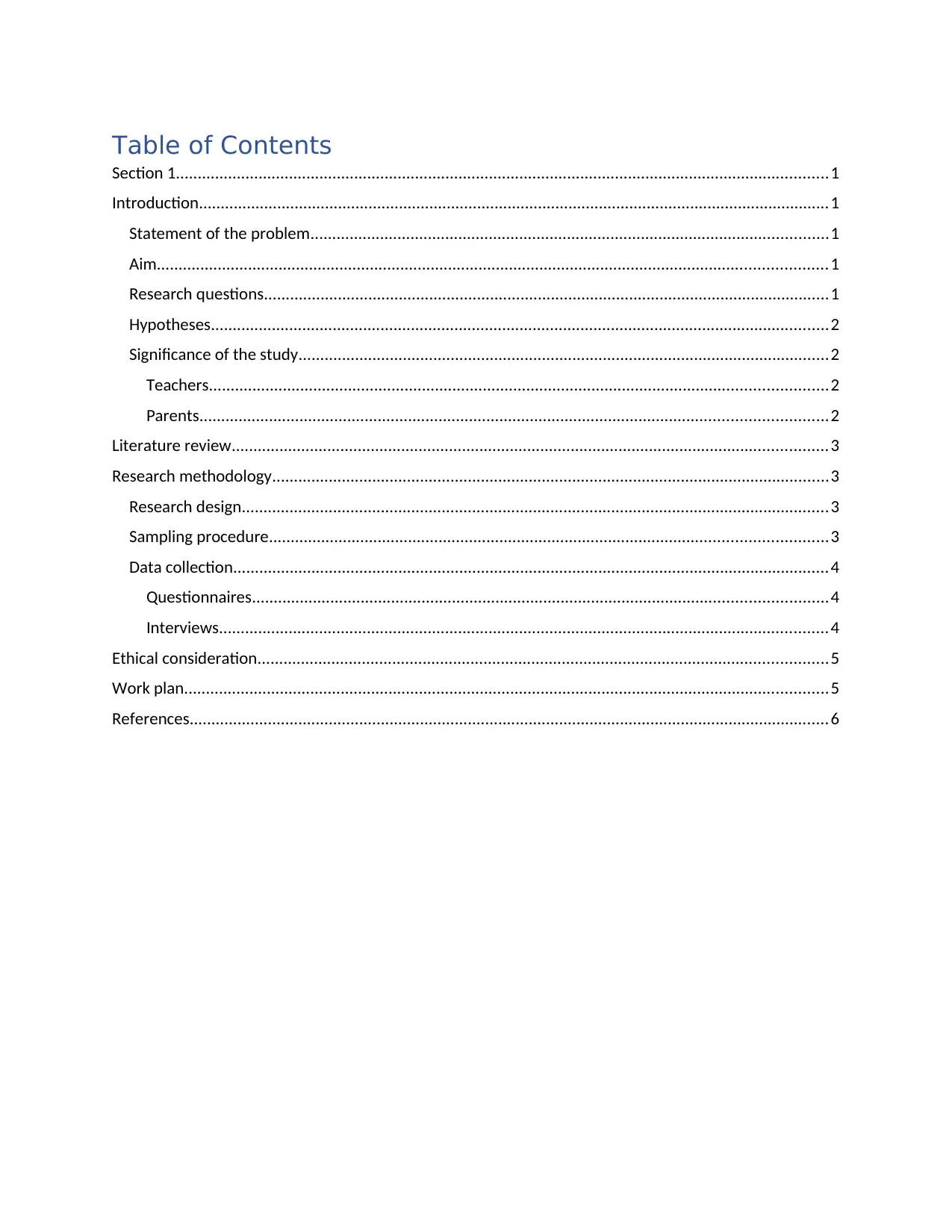
Table of Contents
Section 1......................................................................................................................................................1
Introduction.................................................................................................................................................1
Statement of the problem.......................................................................................................................1
Aim..........................................................................................................................................................1
Research questions..................................................................................................................................1
Hypotheses..............................................................................................................................................2
Significance of the study..........................................................................................................................2
Teachers..............................................................................................................................................2
Parents................................................................................................................................................2
Literature review.........................................................................................................................................3
Research methodology................................................................................................................................3
Research design.......................................................................................................................................3
Sampling procedure................................................................................................................................3
Data collection.........................................................................................................................................4
Questionnaires....................................................................................................................................4
Interviews............................................................................................................................................4
Ethical consideration...................................................................................................................................5
Work plan....................................................................................................................................................5
References...................................................................................................................................................6
Section 1......................................................................................................................................................1
Introduction.................................................................................................................................................1
Statement of the problem.......................................................................................................................1
Aim..........................................................................................................................................................1
Research questions..................................................................................................................................1
Hypotheses..............................................................................................................................................2
Significance of the study..........................................................................................................................2
Teachers..............................................................................................................................................2
Parents................................................................................................................................................2
Literature review.........................................................................................................................................3
Research methodology................................................................................................................................3
Research design.......................................................................................................................................3
Sampling procedure................................................................................................................................3
Data collection.........................................................................................................................................4
Questionnaires....................................................................................................................................4
Interviews............................................................................................................................................4
Ethical consideration...................................................................................................................................5
Work plan....................................................................................................................................................5
References...................................................................................................................................................6
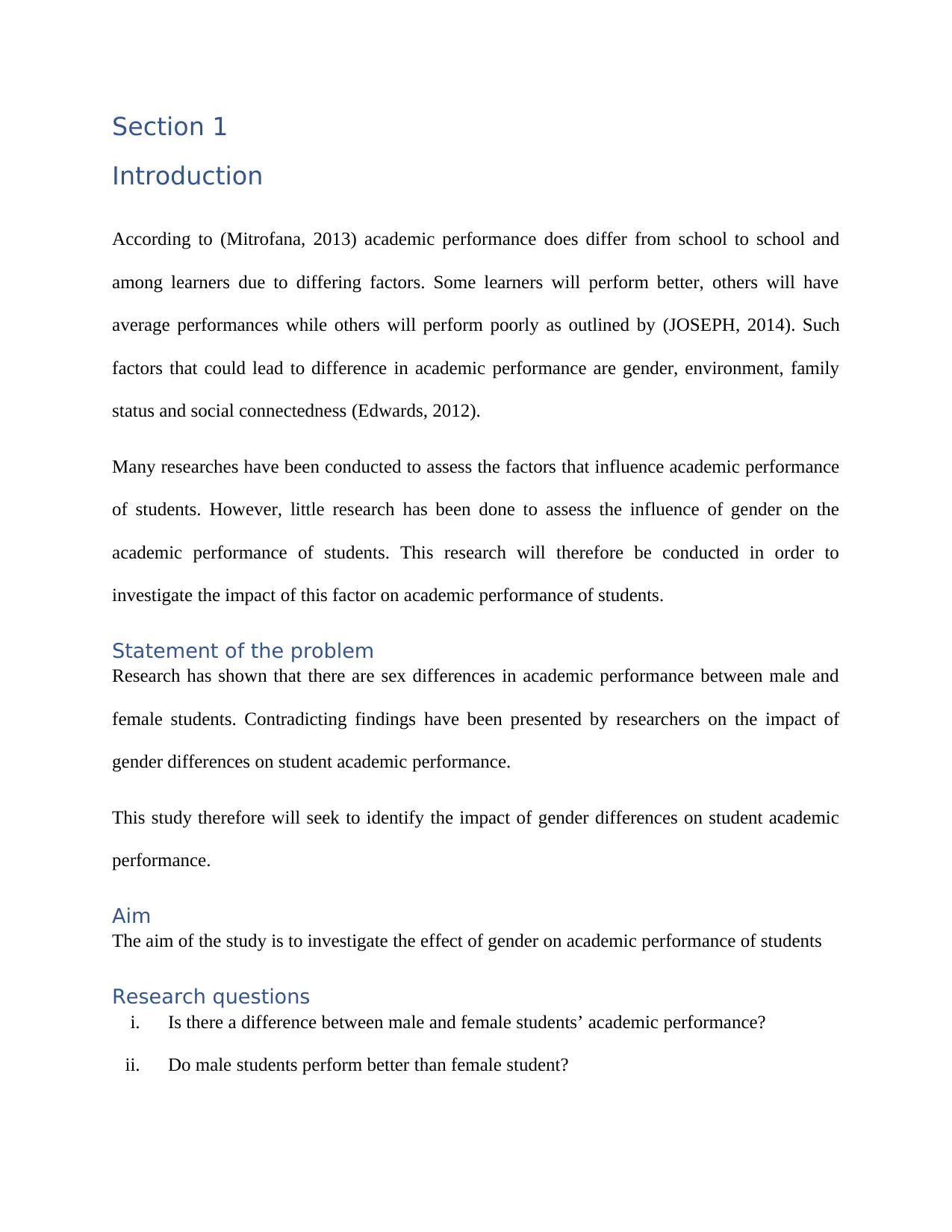
Section 1
Introduction
According to (Mitrofana, 2013) academic performance does differ from school to school and
among learners due to differing factors. Some learners will perform better, others will have
average performances while others will perform poorly as outlined by (JOSEPH, 2014). Such
factors that could lead to difference in academic performance are gender, environment, family
status and social connectedness (Edwards, 2012).
Many researches have been conducted to assess the factors that influence academic performance
of students. However, little research has been done to assess the influence of gender on the
academic performance of students. This research will therefore be conducted in order to
investigate the impact of this factor on academic performance of students.
Statement of the problem
Research has shown that there are sex differences in academic performance between male and
female students. Contradicting findings have been presented by researchers on the impact of
gender differences on student academic performance.
This study therefore will seek to identify the impact of gender differences on student academic
performance.
Aim
The aim of the study is to investigate the effect of gender on academic performance of students
Research questions
i. Is there a difference between male and female students’ academic performance?
ii. Do male students perform better than female student?
Introduction
According to (Mitrofana, 2013) academic performance does differ from school to school and
among learners due to differing factors. Some learners will perform better, others will have
average performances while others will perform poorly as outlined by (JOSEPH, 2014). Such
factors that could lead to difference in academic performance are gender, environment, family
status and social connectedness (Edwards, 2012).
Many researches have been conducted to assess the factors that influence academic performance
of students. However, little research has been done to assess the influence of gender on the
academic performance of students. This research will therefore be conducted in order to
investigate the impact of this factor on academic performance of students.
Statement of the problem
Research has shown that there are sex differences in academic performance between male and
female students. Contradicting findings have been presented by researchers on the impact of
gender differences on student academic performance.
This study therefore will seek to identify the impact of gender differences on student academic
performance.
Aim
The aim of the study is to investigate the effect of gender on academic performance of students
Research questions
i. Is there a difference between male and female students’ academic performance?
ii. Do male students perform better than female student?
⊘ This is a preview!⊘
Do you want full access?
Subscribe today to unlock all pages.

Trusted by 1+ million students worldwide
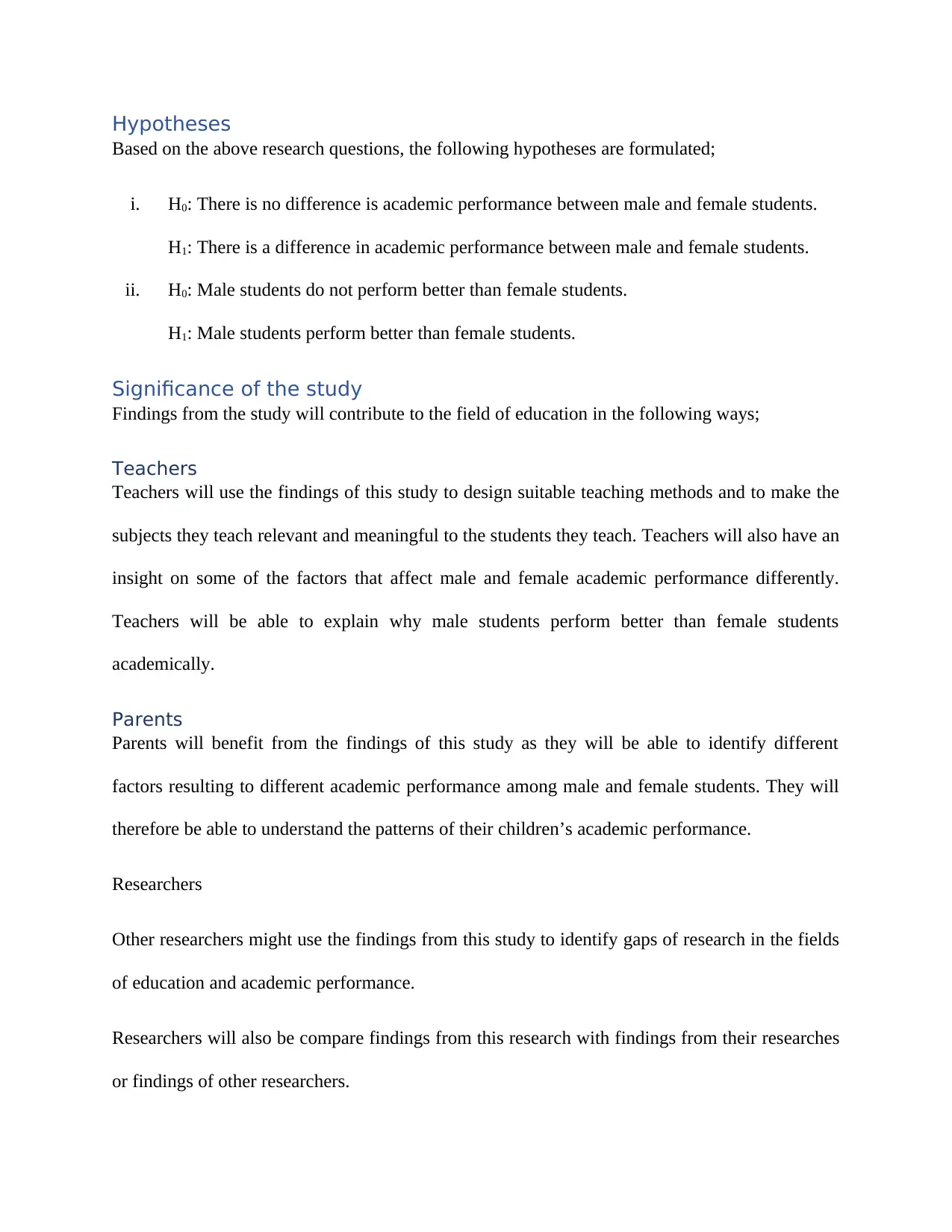
Hypotheses
Based on the above research questions, the following hypotheses are formulated;
i. H0: There is no difference is academic performance between male and female students.
H1: There is a difference in academic performance between male and female students.
ii. H0: Male students do not perform better than female students.
H1: Male students perform better than female students.
Significance of the study
Findings from the study will contribute to the field of education in the following ways;
Teachers
Teachers will use the findings of this study to design suitable teaching methods and to make the
subjects they teach relevant and meaningful to the students they teach. Teachers will also have an
insight on some of the factors that affect male and female academic performance differently.
Teachers will be able to explain why male students perform better than female students
academically.
Parents
Parents will benefit from the findings of this study as they will be able to identify different
factors resulting to different academic performance among male and female students. They will
therefore be able to understand the patterns of their children’s academic performance.
Researchers
Other researchers might use the findings from this study to identify gaps of research in the fields
of education and academic performance.
Researchers will also be compare findings from this research with findings from their researches
or findings of other researchers.
Based on the above research questions, the following hypotheses are formulated;
i. H0: There is no difference is academic performance between male and female students.
H1: There is a difference in academic performance between male and female students.
ii. H0: Male students do not perform better than female students.
H1: Male students perform better than female students.
Significance of the study
Findings from the study will contribute to the field of education in the following ways;
Teachers
Teachers will use the findings of this study to design suitable teaching methods and to make the
subjects they teach relevant and meaningful to the students they teach. Teachers will also have an
insight on some of the factors that affect male and female academic performance differently.
Teachers will be able to explain why male students perform better than female students
academically.
Parents
Parents will benefit from the findings of this study as they will be able to identify different
factors resulting to different academic performance among male and female students. They will
therefore be able to understand the patterns of their children’s academic performance.
Researchers
Other researchers might use the findings from this study to identify gaps of research in the fields
of education and academic performance.
Researchers will also be compare findings from this research with findings from their researches
or findings of other researchers.
Paraphrase This Document
Need a fresh take? Get an instant paraphrase of this document with our AI Paraphraser
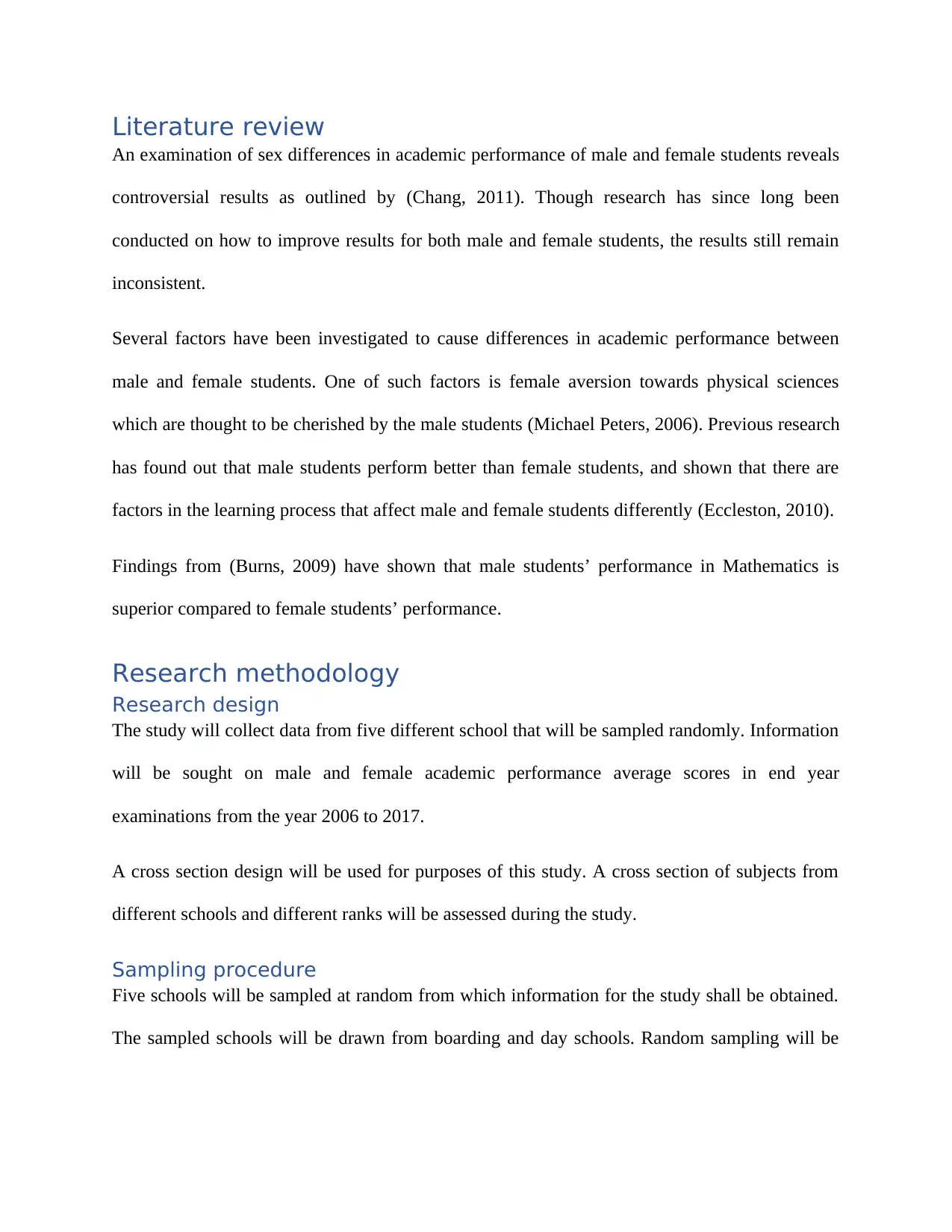
Literature review
An examination of sex differences in academic performance of male and female students reveals
controversial results as outlined by (Chang, 2011). Though research has since long been
conducted on how to improve results for both male and female students, the results still remain
inconsistent.
Several factors have been investigated to cause differences in academic performance between
male and female students. One of such factors is female aversion towards physical sciences
which are thought to be cherished by the male students (Michael Peters, 2006). Previous research
has found out that male students perform better than female students, and shown that there are
factors in the learning process that affect male and female students differently (Eccleston, 2010).
Findings from (Burns, 2009) have shown that male students’ performance in Mathematics is
superior compared to female students’ performance.
Research methodology
Research design
The study will collect data from five different school that will be sampled randomly. Information
will be sought on male and female academic performance average scores in end year
examinations from the year 2006 to 2017.
A cross section design will be used for purposes of this study. A cross section of subjects from
different schools and different ranks will be assessed during the study.
Sampling procedure
Five schools will be sampled at random from which information for the study shall be obtained.
The sampled schools will be drawn from boarding and day schools. Random sampling will be
An examination of sex differences in academic performance of male and female students reveals
controversial results as outlined by (Chang, 2011). Though research has since long been
conducted on how to improve results for both male and female students, the results still remain
inconsistent.
Several factors have been investigated to cause differences in academic performance between
male and female students. One of such factors is female aversion towards physical sciences
which are thought to be cherished by the male students (Michael Peters, 2006). Previous research
has found out that male students perform better than female students, and shown that there are
factors in the learning process that affect male and female students differently (Eccleston, 2010).
Findings from (Burns, 2009) have shown that male students’ performance in Mathematics is
superior compared to female students’ performance.
Research methodology
Research design
The study will collect data from five different school that will be sampled randomly. Information
will be sought on male and female academic performance average scores in end year
examinations from the year 2006 to 2017.
A cross section design will be used for purposes of this study. A cross section of subjects from
different schools and different ranks will be assessed during the study.
Sampling procedure
Five schools will be sampled at random from which information for the study shall be obtained.
The sampled schools will be drawn from boarding and day schools. Random sampling will be
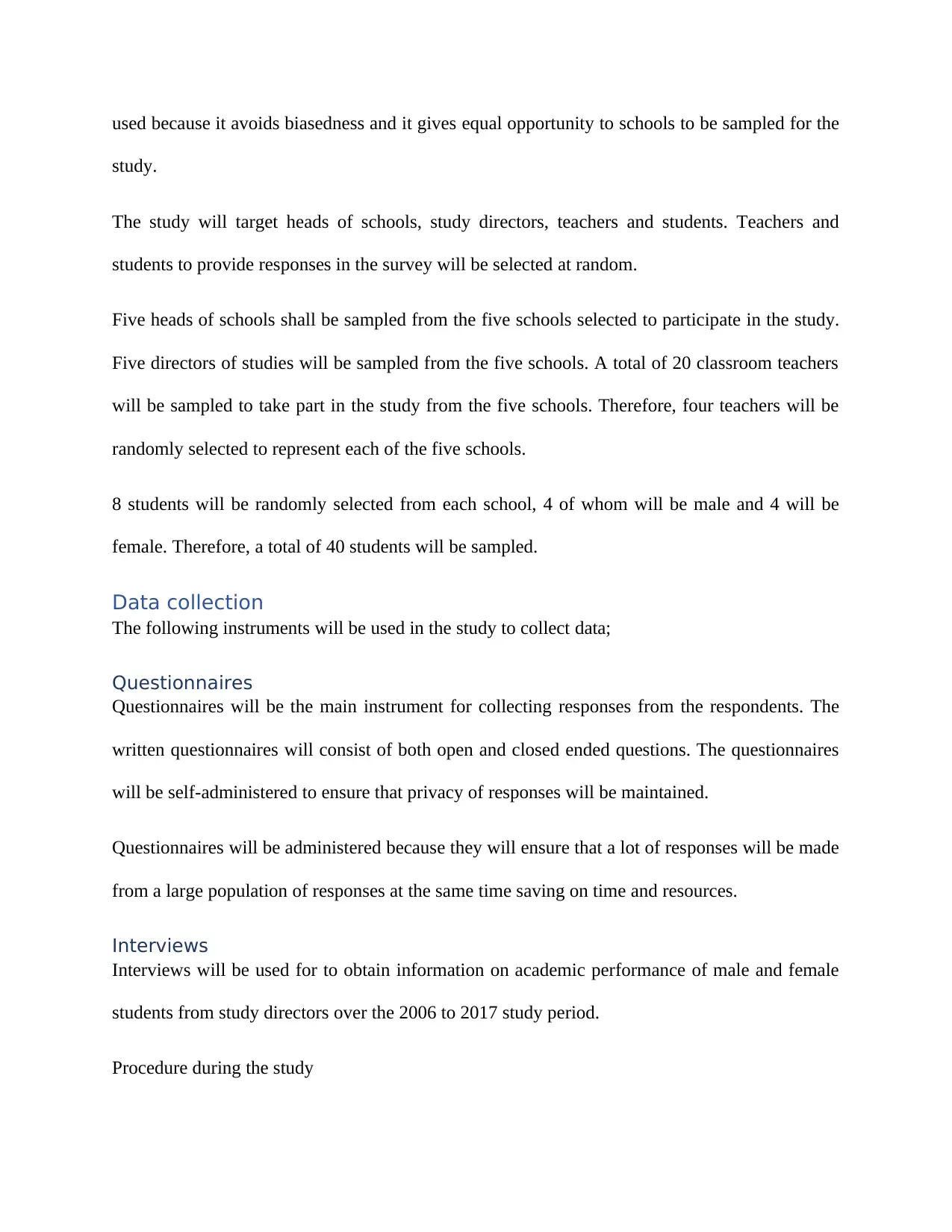
used because it avoids biasedness and it gives equal opportunity to schools to be sampled for the
study.
The study will target heads of schools, study directors, teachers and students. Teachers and
students to provide responses in the survey will be selected at random.
Five heads of schools shall be sampled from the five schools selected to participate in the study.
Five directors of studies will be sampled from the five schools. A total of 20 classroom teachers
will be sampled to take part in the study from the five schools. Therefore, four teachers will be
randomly selected to represent each of the five schools.
8 students will be randomly selected from each school, 4 of whom will be male and 4 will be
female. Therefore, a total of 40 students will be sampled.
Data collection
The following instruments will be used in the study to collect data;
Questionnaires
Questionnaires will be the main instrument for collecting responses from the respondents. The
written questionnaires will consist of both open and closed ended questions. The questionnaires
will be self-administered to ensure that privacy of responses will be maintained.
Questionnaires will be administered because they will ensure that a lot of responses will be made
from a large population of responses at the same time saving on time and resources.
Interviews
Interviews will be used for to obtain information on academic performance of male and female
students from study directors over the 2006 to 2017 study period.
Procedure during the study
study.
The study will target heads of schools, study directors, teachers and students. Teachers and
students to provide responses in the survey will be selected at random.
Five heads of schools shall be sampled from the five schools selected to participate in the study.
Five directors of studies will be sampled from the five schools. A total of 20 classroom teachers
will be sampled to take part in the study from the five schools. Therefore, four teachers will be
randomly selected to represent each of the five schools.
8 students will be randomly selected from each school, 4 of whom will be male and 4 will be
female. Therefore, a total of 40 students will be sampled.
Data collection
The following instruments will be used in the study to collect data;
Questionnaires
Questionnaires will be the main instrument for collecting responses from the respondents. The
written questionnaires will consist of both open and closed ended questions. The questionnaires
will be self-administered to ensure that privacy of responses will be maintained.
Questionnaires will be administered because they will ensure that a lot of responses will be made
from a large population of responses at the same time saving on time and resources.
Interviews
Interviews will be used for to obtain information on academic performance of male and female
students from study directors over the 2006 to 2017 study period.
Procedure during the study
⊘ This is a preview!⊘
Do you want full access?
Subscribe today to unlock all pages.

Trusted by 1+ million students worldwide
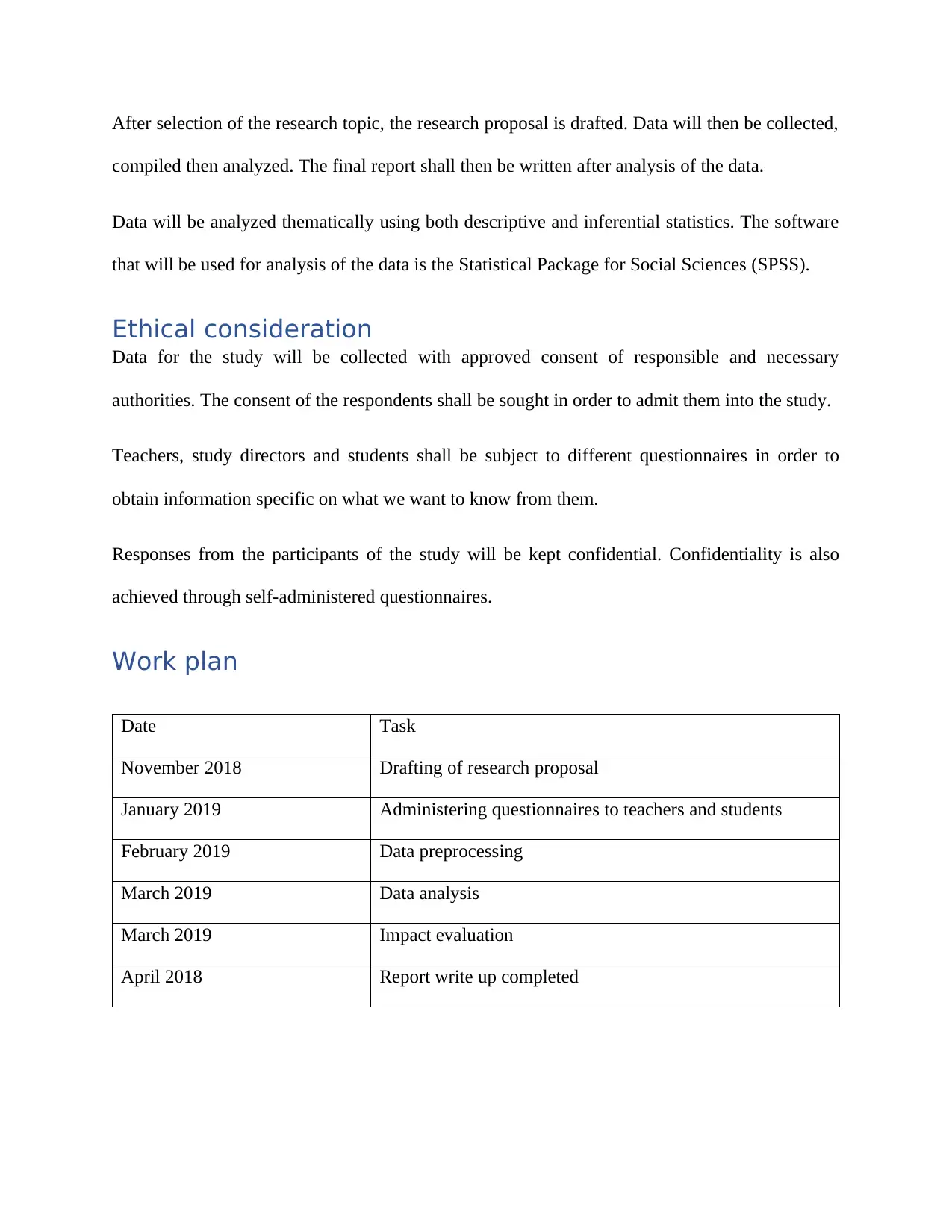
After selection of the research topic, the research proposal is drafted. Data will then be collected,
compiled then analyzed. The final report shall then be written after analysis of the data.
Data will be analyzed thematically using both descriptive and inferential statistics. The software
that will be used for analysis of the data is the Statistical Package for Social Sciences (SPSS).
Ethical consideration
Data for the study will be collected with approved consent of responsible and necessary
authorities. The consent of the respondents shall be sought in order to admit them into the study.
Teachers, study directors and students shall be subject to different questionnaires in order to
obtain information specific on what we want to know from them.
Responses from the participants of the study will be kept confidential. Confidentiality is also
achieved through self-administered questionnaires.
Work plan
Date Task
November 2018 Drafting of research proposal
January 2019 Administering questionnaires to teachers and students
February 2019 Data preprocessing
March 2019 Data analysis
March 2019 Impact evaluation
April 2018 Report write up completed
compiled then analyzed. The final report shall then be written after analysis of the data.
Data will be analyzed thematically using both descriptive and inferential statistics. The software
that will be used for analysis of the data is the Statistical Package for Social Sciences (SPSS).
Ethical consideration
Data for the study will be collected with approved consent of responsible and necessary
authorities. The consent of the respondents shall be sought in order to admit them into the study.
Teachers, study directors and students shall be subject to different questionnaires in order to
obtain information specific on what we want to know from them.
Responses from the participants of the study will be kept confidential. Confidentiality is also
achieved through self-administered questionnaires.
Work plan
Date Task
November 2018 Drafting of research proposal
January 2019 Administering questionnaires to teachers and students
February 2019 Data preprocessing
March 2019 Data analysis
March 2019 Impact evaluation
April 2018 Report write up completed
Paraphrase This Document
Need a fresh take? Get an instant paraphrase of this document with our AI Paraphraser
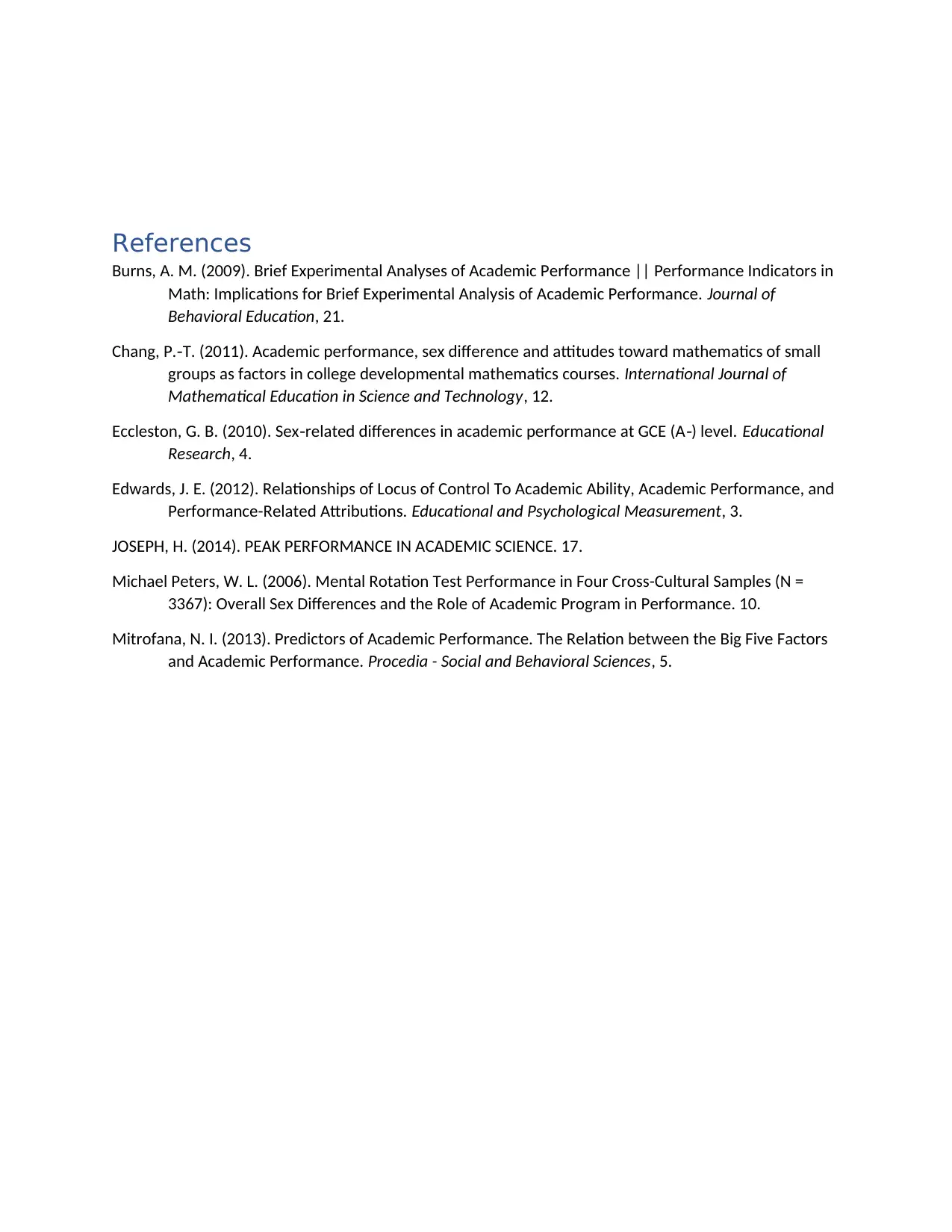
References
Burns, A. M. (2009). Brief Experimental Analyses of Academic Performance || Performance Indicators in
Math: Implications for Brief Experimental Analysis of Academic Performance. Journal of
Behavioral Education, 21.
Chang, P. T. (2011). Academic performance, sex difference and attitudes toward mathematics of small‐
groups as factors in college developmental mathematics courses. International Journal of
Mathematical Education in Science and Technology, 12.
Eccleston, G. B. (2010). Sex related differences in academic performance at GCE (A ) level.‐ ‐ Educational
Research, 4.
Edwards, J. E. (2012). Relationships of Locus of Control To Academic Ability, Academic Performance, and
Performance-Related Attributions. Educational and Psychological Measurement, 3.
JOSEPH, H. (2014). PEAK PERFORMANCE IN ACADEMIC SCIENCE. 17.
Michael Peters, W. L. (2006). Mental Rotation Test Performance in Four Cross-Cultural Samples (N =
3367): Overall Sex Differences and the Role of Academic Program in Performance. 10.
Mitrofana, N. I. (2013). Predictors of Academic Performance. The Relation between the Big Five Factors
and Academic Performance. Procedia - Social and Behavioral Sciences, 5.
Burns, A. M. (2009). Brief Experimental Analyses of Academic Performance || Performance Indicators in
Math: Implications for Brief Experimental Analysis of Academic Performance. Journal of
Behavioral Education, 21.
Chang, P. T. (2011). Academic performance, sex difference and attitudes toward mathematics of small‐
groups as factors in college developmental mathematics courses. International Journal of
Mathematical Education in Science and Technology, 12.
Eccleston, G. B. (2010). Sex related differences in academic performance at GCE (A ) level.‐ ‐ Educational
Research, 4.
Edwards, J. E. (2012). Relationships of Locus of Control To Academic Ability, Academic Performance, and
Performance-Related Attributions. Educational and Psychological Measurement, 3.
JOSEPH, H. (2014). PEAK PERFORMANCE IN ACADEMIC SCIENCE. 17.
Michael Peters, W. L. (2006). Mental Rotation Test Performance in Four Cross-Cultural Samples (N =
3367): Overall Sex Differences and the Role of Academic Program in Performance. 10.
Mitrofana, N. I. (2013). Predictors of Academic Performance. The Relation between the Big Five Factors
and Academic Performance. Procedia - Social and Behavioral Sciences, 5.
1 out of 8
Related Documents
Your All-in-One AI-Powered Toolkit for Academic Success.
+13062052269
info@desklib.com
Available 24*7 on WhatsApp / Email
![[object Object]](/_next/static/media/star-bottom.7253800d.svg)
Unlock your academic potential
Copyright © 2020–2025 A2Z Services. All Rights Reserved. Developed and managed by ZUCOL.





